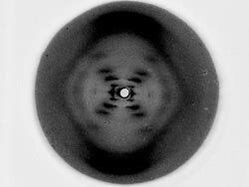Franklin and Bangham were looking at how the thermal expansion of charcoal and coal was affected by the amount of methanol was saturated in the coal or charcoal. The expansion of charcoals with the absorbed films of alcohols is harder to measure since it's very complex: at first it expands much faster than dry charcoal, but then it shrinks before expanding again due to the moisture evaporating from it. Franklin and Bangham devised a method to measure this more accurately by a method of preheating the coals to high temperatures. After this paper was published, Franklin published her own journal article in 1948 ("A Study of of The Fine Structures Of Carbonaceous Solids by Measurements of True and Apparent Densities: Part I. Coals," 1948, shown below) which detailed her experiments in apparent density of coals at BCURA.
Smaller molecules (helium is a great) give apparent densities closer to the true densities of materials. No matter how small of a molecule you use, however, it will not fill completely closed off holes in the material. The fluids Franklin used in her experiment were helium gas, methanol, water, n-Hexane, and benzene. The chemical structures of these gasses and liquids are shown in the above order below. (Note: If you are not familiar with Lewis Structure notation, in short, the two dots represent unbonded electrons and the lines represent bonds. (The triangle shapes in the structure for n-Hexane indicate 3D shape.)) Image credits, from left to right: 1. www.chemistrylearner.com/helium.html, 2. web.chem.ucla.edu/~harding/IGOC/M/methanol.html, 3. socratic.org/questions/5495372e581e2a1c2d5edb9f, 4. socratic.org/questions/595fa291b72cff185f0768e2, 5. arstechnica.com/science/2017/02/researchers-individually-craft-molecules-of-a-reactive-triangular-chemical/ The second part of Franklin's article, "A Study of of The Fine Structures Of Carbonaceous Solids by Measurements of True and Apparent Densities: Part II. Carbonized Coals" (shown below) was published in 1949.
* Full citation: Periodical. Bangham, D. H., and Rosalind Franklin. "Thermal Expansion of Coals and Carbonised Coals." Transactions of the Faraday Society 48, (1946): 289-295. Article. 7 Images.. Transactions of the Faraday Society
** Full citation: Periodical. Franklin, Rosalind. "A Study of the Fine Structure of Carbonaceous Solids by Measurements of True and Apparent Densities: Part I. Coals." Transactions of the Faraday Society 45, (1949): 274-286. Article. 13 Images.. Transactions of the Faraday Society *** Full citation: Periodical. Franklin, Rosalind. "A Study of the Fine Structure of Carbonaceous Solids by Measurements of True and Apparent Densities: Part II. -- Carbonized Coals." Transactions of the Faraday Society 45, (1949): 668-682. Article. 15 Images.. Transactions of the Faraday Society
3 Comments
Mia
12/14/2021 11:59:20 am
What a lovely simplification of some of Franklin's work! It is so interesting, and so little-known. Fantastic.
Reply
Nathan Eberhart
12/14/2021 04:54:23 pm
It's really interesting how you're able to simplify her work. It's also cool that you're taking the time to explore her earlier work and truly understand it rather than just focusing on her most famous discovery.
Reply
Nathan Rabinovitch
12/15/2021 06:42:08 am
I had no idea that Rosalind Franklin was at all involved with coal before these blog posts. This concise piece is great at conveying the research she was working on to the reader.
Reply
Leave a Reply. |
AuthorLoren Sinclair is a high school student interested in chemistry, art, computer science, theater, and everything else! They are writing this blog to tell Rosalind Franklin's often untold tale, from her life story to the science behind her work. Archives
January 2022
CategoriesSources |






